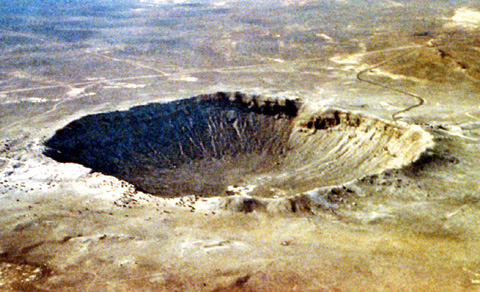A hundred years ago this week, a gigantic explosion ripped open the dawn sky above the swampy taiga forest of western Siberia, leaving a scientific riddle that endures to this day.
A dazzling light pierced the heavens, preceding a shock wave with the power of a thousand atomic bombs that flattened 80 million trees in a swathe of more than 2,000km².
Evenki nomads recounted how the blast tossed homes and animals into the air. In Irkutsk, 1,500km away, seismic sensors registered what was initially deemed to be an earthquake.

PHOTO: AFP
The fireball was so great that a day later, Londoners could read their newspapers under the night sky.
What caused the so-called Tunguska Event, named after the Podkamennaya Tunguska river near where it happened, has spawned at least a half a dozen theories.
The biggest finger of blame points at a rogue rock whose destiny, after traveling in space for millions of years, was to intersect with Earth at exactly 7:17am on June 30, 1908.
Even the most ardent defenders of the sudden impact theory acknowledge there are many gaps. They strive to find answers, believing this will strengthen defenses against future Tunguska-type threats, which experts say occur at a frequency ranging from one in 200 years to one in 1,000 years.
“Imagine an unspotted asteroid laying waste to a significant chunk of land and imagine if that area, unlike Tunguska and a surprising amount of the globe today, were populated,” the British science journal Nature commented last week.
If a rock was the culprit, the choices lie between an asteroid — the rubble that can be jostled out of its orbital belt between Mars and Jupiter and set on collision course with Earth — and a comet, one of the “icy dirtballs” of frozen, primeval material that loop around the Solar System.
WHERE ARE THE FRAGMENTS?
Comets move at far greater speeds than asteroids, which means they release more kinetic energy kilogram-for-kilogram upon impact. A small comet would deliver the same punch as a larger asteroid.
But no fragments of the Tunguska villain have ever been found, despite many searches.
Finding a piece is important, for it will boost our knowledge about the degrees of risk from dangerous Near Earth Objects (NEOs), say Italian researchers Luca Gasperini, Enrico Bonatti and Giuseppe Longo.
When a new asteroid is detected, its orbit can be plotted for scores of years in the future.
Comets are far less numerous than asteroids but are rather more worrying, as they are largely an unknown entity.
Most comets have yet to be spotted because they take decades or even hundreds of years to go around the Sun and pass our home. As a result, any comet on a collision course with Earth could quite literally come out of the dark, leaving us negligible time to respond.
“If the Tunguska event was in fact caused by a comet, it would be a unique occurrence rather than an important case study of a known class of phenomena,” Gasperini’s team said in last month’s issue of Scientific American.
“On the other hand, if an asteroid did explode in the Siberian skies that June morning, why has no one yet found fragments?”
NEO experts are likewise unsure about the size of the object.
Estimates, based on the scale of ground destruction, range from 3m to 70m.
All agree that the object, heated by friction with atmospheric molecules, exploded far above ground — up to 10km away.
But there is fierce debate as to whether any debris hit the ground.
This too is important. When the next Tunguska NEO looms, Earth’s guardians will have to choose whether to try to deflect it or blow it up in space, with the risk that objects of a certain size may survive the fiery passage through the atmosphere and hit the planet.
The Italian trio believe the answers lie in a curiously-shaped oval lake, called Lake Cheko, located about 10km from ground zero.
Computer models, they say, suggest it is the impact crater from a 1m-sized fragment that survived the explosion.
They plan a return expedition to Lake Cheko in the hope of reaching a dense object of this size, buried 10m in the lake’s cone-shaped floor, that reflected sonar waves.
But what if neither comet nor asteroid were to blame?
A rival theory is given an airing in the New Scientist.
Lake Cheko does not have the typical round shape of an impact crater, and no extraterrestrial material has been found, which means “there’s got to be a terrestrial explanation,” Wolfgang Kundt, a physicist at Germany’s Bonn University told the British weekly.
He believes the Tunguska Event was caused by a massive escape of 10 million tonnes of methane-rich gas deep within Earth’s crust. Evidence of a similar apocalyptic release can be found on the Blake Ridge on the seabed off Norway, a “pockmark” of 700km², Kundt said.

The Democratic Progressive Party (DPP), Chinese Nationalist Party (KMT), and the country’s other political groups dare not offend religious groups, says Chen Lih-ming (陳立民), founder of the Taiwan Anti-Religion Alliance (台灣反宗教者聯盟). “It’s the same in other democracies, of course, but because political struggles in Taiwan are extraordinarily fierce, you’ll see candidates visiting several temples each day ahead of elections. That adds impetus to religion here,” says the retired college lecturer. In Japan’s most recent election, the Liberal Democratic Party lost many votes because of its ties to the Unification Church (“the Moonies”). Chen contrasts the progress made by anti-religion movements in

Last week the State Department made several small changes to its Web information on Taiwan. First, it removed a statement saying that the US “does not support Taiwan independence.” The current statement now reads: “We oppose any unilateral changes to the status quo from either side. We expect cross-strait differences to be resolved by peaceful means, free from coercion, in a manner acceptable to the people on both sides of the Strait.” In 2022 the administration of Joe Biden also removed that verbiage, but after a month of pressure from the People’s Republic of China (PRC), reinstated it. The American

Chinese Nationalist Party (KMT) legislative caucus convener Fu Kun-chi (傅?萁) and some in the deep blue camp seem determined to ensure many of the recall campaigns against their lawmakers succeed. Widely known as the “King of Hualien,” Fu also appears to have become the king of the KMT. In theory, Legislative Speaker Han Kuo-yu (韓國瑜) outranks him, but Han is supposed to be even-handed in negotiations between party caucuses — the Democratic Progressive Party (DPP) says he is not — and Fu has been outright ignoring Han. Party Chairman Eric Chu (朱立倫) isn’t taking the lead on anything while Fu

Feb 24 to March 2 It’s said that the entire nation came to a standstill every time The Scholar Swordsman (雲州大儒俠) appeared on television. Children skipped school, farmers left the fields and workers went home to watch their hero Shih Yen-wen (史艷文) rid the world of evil in the 30-minute daily glove puppetry show. Even those who didn’t speak Hoklo (commonly known as Taiwanese) were hooked. Running from March 2, 1970 until the government banned it in 1974, the show made Shih a household name and breathed new life into the faltering traditional puppetry industry. It wasn’t the first